
A rose is a woody perennial flowering plant of the genus Rosa, in the family Rosaceae, or the flower it bears. There are over three hundred species and tens of thousands of cultivars. They form a group of plants that can be erect shrubs, climbing, or trailing, with stems that are often armed with sharp prickles. Flowers vary in size and shape and are usually large and showy, in colours ranging from white through yellows and reds. Most species are native to Asia, with smaller numbers native to Europe, North America, and northwestern Africa. Species, cultivars and hybrids are all widely grown for their beauty and often are fragrant. Roses have acquired cultural significance in many societies. Rose plants range in size from compact, miniature roses, to climbers that can reach seven meters in height. Different species hybridize easily, and this has been used in the development of the wide range of garden roses.

Magnolia is a large genus of about 210 flowering plant species in the subfamily Magnolioideae of the family Magnoliaceae. It is named after French botanist Pierre Magnol.
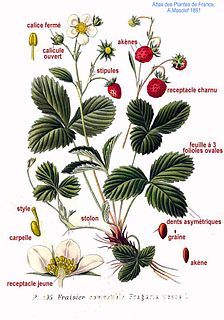
Fragaria is a genus of flowering plants in the rose family, Rosaceae, commonly known as strawberries for their edible fruits. There are more than 20 described species and many hybrids and cultivars. The most common strawberries grown commercially are cultivars of the garden strawberry, a hybrid known as Fragaria × ananassa. Strawberries have a taste that varies by cultivar, and ranges from quite sweet to rather tart. Strawberries are an important commercial fruit crop, widely grown in all temperate regions of the world.

Sorghum is a genus of about 25 species of flowering plants in the grass family Poaceae. Some of these species have grown as cereals for human consumption and some in pastures for animals. One species, Sorghum bicolor, was originally domesticated in Africa and has since spread throughout the globe. Seventeen of the 25 species are native to Australia, with the range of some extending to Africa, Asia, Mesoamerica, and certain islands in the Indian and Pacific Oceans. One species is grown for grain, while many others are used as fodder plants, either cultivated in warm climates worldwide or naturalized in pasture lands. Sorghum is in the subfamily Panicoideae and the tribe Andropogoneae.

Hydrangea common names hydrangea or hortensia, is a genus of 70–75 species of flowering plants native to Asia and the Americas. By far the greatest species diversity is in eastern Asia, notably Korea, China, and Japan. Most are shrubs 1 to 3 meters tall, but some are small trees, and others lianas reaching up to 30 m (98 ft) by climbing up trees. They can be either deciduous or evergreen, though the widely cultivated temperate species are all deciduous.
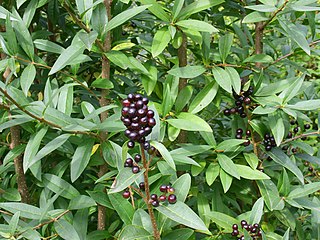
A privet is a flowering plant in the genus Ligustrum. The genus contains about 50 species of erect, deciduous or evergreen shrubs, sometimes forming small or medium-sized trees, native to Europe, north Africa, Asia, many introduced and naturalised in Australasia, where only one species extends as a native into Queensland. Some species have become widely naturalized or invasive where introduced. Privet was originally the name for the European semi-evergreen shrub Ligustrum vulgare, and later also for the more reliably evergreen Ligustrum ovalifolium and its hybrid Ligustrum × ibolium used extensively for privacy hedging, though now the name is applied to all members of the genus. The generic name was applied by Pliny the Elder to L. vulgare. It is often suggested that the name privet is related to private, but the OED states that there is no evidence to support this.
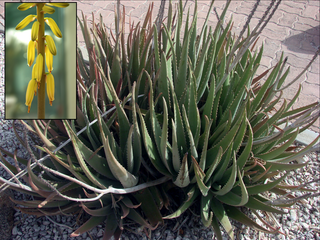
Aloe vera is a succulent plant species of the genus Aloe. An evergreen perennial, it originates from the Arabian Peninsula, but grows wild in tropical, semi-tropical, and arid climates around the world. It is cultivated for agricultural and medicinal uses. The species is also used for decorative purposes and grows successfully indoors as a potted plant.

Zanthoxylum is a genus of about 250 species of deciduous and evergreen trees, shrubs and climbers in the family Rutaceae that are native to warm temperate and subtropical areas worldwide. It is the type genus of the tribe Zanthoxyleae in the subfamily Rutoideae. Several of the species have yellow heartwood, to which their generic name alludes.

Alangium is a small genus of flowering plants. The genus is included either in a broad view of the dogwood family Cornaceae, or as the sole member of its own family Alangiaceae. Alangium has about 40 species, but some of the species boundaries are not entirely clear. The type species for Alangium is Alangium decapetalum, which is now treated as a subspecies of Alangium salviifolium. All of the species are shrubs or small trees, except the liana Alangium kwangsiense. A. chinense, A. platanifolium, and A. salviifolium are known in cultivation.
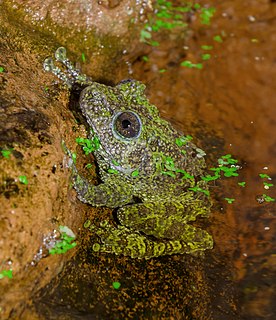
Theloderma corticale is a species of frog in the family Rhacophoridae. It is found in northern Vietnam and China, and possibly in adjacent Laos.

Gymnostachyum is an Asian genus of plants in the family Acanthaceae.

Helicia is a genus of 110 species of trees and shrubs, constituting part of the plant family Proteaceae. They grow naturally in rainforests throughout tropical South and Southeast Asia, including India, Sri Lanka, Indochina, Peninsular Malaysia to New Guinea and as far south as New South Wales.

The flora of China is diverse. More than 30,000 plant species are native to China, representing nearly one-eighth of the world's total plant species, including thousands found nowhere else on Earth.

Gymnostachyum febrifugum is a herb endemic to the southern Western Ghats of India. It has medicinal value.
Dolichopetalum is a genus of plants in the family Apocynaceae, first described as a genus in 1973. It contains only one known species, Dolichopetalum kwangsiense, endemic to China, known from the Provinces of Guangxi, Guizhou, and Yunnan.

Ecbolium is a genus of flowering plants in the family Acanthaceae.

Gymnostachyum ceylanicum is a small plant endemic to Sri Lanka. Plants grow to heights of 5-15 centimeters, with simple leaves that are opposite, and racemes of light-purple tubular flowers.
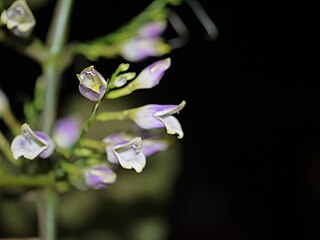
Gymnostachyum warrieranum is a small plant endemic to Western Ghats in India. The plant would grow up to 70 cm and flower between November and March.

Acanthoideae is a subfamily of plants in the family Acanthaceae.


















